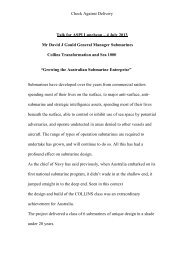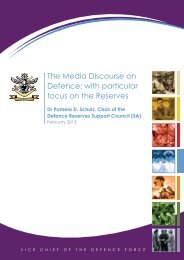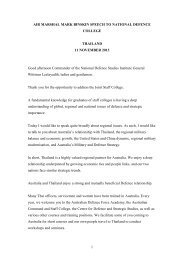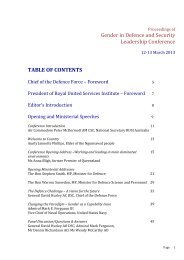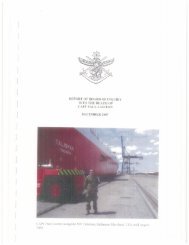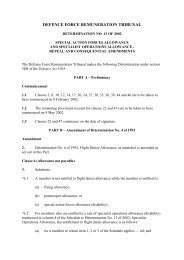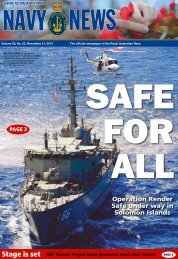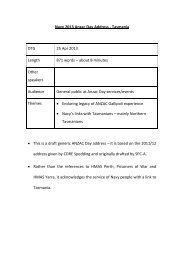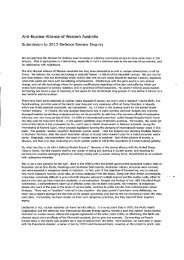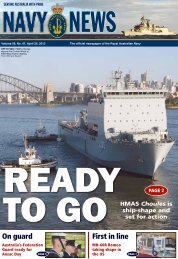DMO Bulletin For Industry - Department of Defence
DMO Bulletin For Industry - Department of Defence
DMO Bulletin For Industry - Department of Defence
Create successful ePaper yourself
Turn your PDF publications into a flip-book with our unique Google optimized e-Paper software.
Handling<br />
tHe Heat<br />
Ensuring the ADF’s<br />
equipment is up<br />
to scratch<br />
Getting the job done<br />
Acquiring the Skandi Bergen<br />
<strong>Bulletin</strong><br />
SRP collaboration<br />
<strong>DMO</strong> and industry work together to<br />
achieve savings<br />
<strong>DMO</strong> PURPOSE | Equip and Sustain the Australian <strong>Defence</strong> <strong>For</strong>ce<br />
ISSUE 2 2012
Thanks to everyone who<br />
provided background<br />
information for the articles in<br />
this edition <strong>of</strong> the<br />
<strong>DMO</strong> <strong>Bulletin</strong>.<br />
Special thanks to the<br />
following:<br />
Writing/Editing/Pro<strong>of</strong>ing<br />
Harry Baxter<br />
Luke Brown<br />
Wendy Messer<br />
Michelle Perks<br />
Richard Stevenson<br />
Graphic Design<br />
Mic Bowbrick<br />
Zuzana Milne<br />
Artwork styled and produced<br />
by <strong>DMO</strong> Communications.<br />
Please contact the <strong>DMO</strong><br />
<strong>Bulletin</strong> Editor if you would<br />
like to re-use any part <strong>of</strong> this<br />
publication.<br />
All republished articles<br />
must be attributed to<br />
the <strong>DMO</strong> <strong>Bulletin</strong>.<br />
Contact the<br />
<strong>DMO</strong> <strong>Bulletin</strong> Editor,<br />
Michelle Perks, with your<br />
story ideas:<br />
e: dmo.bulletin@<br />
defence.gov.au<br />
p: 02 6265 1636<br />
<strong>For</strong> general enquiries or<br />
support please email the<br />
<strong>DMO</strong> Communications team:<br />
e: dmo.communication@<br />
defence.gov.au<br />
The editorial team reserves<br />
the right to edit and rearrange<br />
all items in the <strong>DMO</strong> <strong>Bulletin</strong><br />
for the reasons <strong>of</strong> clarity and<br />
space. While the editorial<br />
team isn’t responsible for the<br />
accuracy <strong>of</strong> the information<br />
submitted, every reasonable<br />
effort will be made to verify<br />
content.<br />
MARCH:<br />
APRIL:<br />
MAY:<br />
IN THE NEWS<br />
The Australian <strong>Defence</strong> <strong>For</strong>ce (ADF) will have access to an additional C-17<br />
following Government approval to purchase a sixth aircraft through the United<br />
States (US) <strong>For</strong>eign Military Sales (FMS) program. The sixth C-17 has been<br />
acquired for $280 million and is expected to arrive in Australia early<br />
next year.<br />
A second Shadow 200 Tactical Unmanned Aerial System (TUAS) will be<br />
delivered for use to Australian troops preparing to deploy to Afghanistan,<br />
almost one year ahead <strong>of</strong> schedule. While this TUAS was originally scheduled<br />
to be delivered in the first half <strong>of</strong> 2013, the US has agreed to deliver it in the<br />
first half <strong>of</strong> 2012.<br />
The Air Warfare Destroyer program has reached an important milestone<br />
following the arrival in Adelaide <strong>of</strong> the first <strong>of</strong> three state <strong>of</strong> the art horizonsearch<br />
radars.The radars were purchased for around $10 million each and will<br />
be used to search and track targets immediately above the sea surface.<br />
The Minister for <strong>Defence</strong> Materiel, Jason Clare, held a two-day summit with<br />
senior <strong>Defence</strong> Officials and the CEOs <strong>of</strong> companies involved with Projects <strong>of</strong><br />
Concern, to ensure that the “people responsible for these projects are doing<br />
everything necessary to remediate them.” According to Minister Clare, these<br />
meetings “bring the right people together and focus them on getting these<br />
projects back on track and <strong>of</strong>f the list.” There are currently six projects on the<br />
Projects <strong>of</strong> Concern list.<br />
Nine Australian companies are being <strong>of</strong>fered more than $12 million in matched<br />
funding to commercialise new defence technologies that will contribute to<br />
Australia’s Priority <strong>Industry</strong> Capabilities (PICs) in the defence sector. Over the<br />
next seven years $45 million will be invested in PICs through this program. The<br />
Minister for <strong>Defence</strong> Materiel, Jason Clare, said the funding “is about making<br />
sure our troops have the equipment they need to do their job.”<br />
The Government has appointed a General Manager <strong>of</strong> Submarines to take<br />
responsibility for all materiel related aspects <strong>of</strong> submarine support across<br />
<strong>Defence</strong>. David Gould has been appointed to the position and will answer to<br />
the CEO <strong>DMO</strong>. The Government also announced that it would provide $214<br />
million for the next stage <strong>of</strong> the Future Submarines Project. This funding will<br />
go towards further detailed studies and analysis to inform the Government’s<br />
decision on the design <strong>of</strong> Australia’s next submarine.<br />
The Prime Minister and the Minister for <strong>Defence</strong> have released the final report<br />
<strong>of</strong> the Australian <strong>Defence</strong> <strong>For</strong>ce Posture Review. This review addresses a<br />
range <strong>of</strong> present and emerging global, regional and national strategic and<br />
security factors that require careful consideration for the future. The <strong>For</strong>ce<br />
Posture Review will feed into the 2013 <strong>Defence</strong> White Paper.<br />
Access the <strong>DMO</strong>’s latest news on the <strong>DMO</strong> website.<br />
The <strong>DMO</strong>: www.defence.gov.au/dmo<br />
Skilling Australia's <strong>Defence</strong> <strong>Industry</strong>: www.defence.gov.au/dmo/id/sadi<br />
The <strong>Defence</strong> and <strong>Industry</strong> ePortal: www.dplusi.defence.gov.au<br />
<strong>DMO</strong> <strong>Bulletin</strong> Issue 2 2012 | 2
Deming’s words are a good warning<br />
against over-optimism and blind faith.<br />
Clearly one <strong>of</strong> the <strong>DMO</strong>’s most important<br />
tasks is delivering what the ADF needs, when<br />
they need it and within the affordability and<br />
scope requirements approved by Government.<br />
We cannot fulfil this task effectively without<br />
thorough and accurate analysis <strong>of</strong> the<br />
requirements, cost, schedule and risks<br />
associated with every project.<br />
Simply parroting the project ambitions for<br />
capability, cost and schedule that were<br />
envisaged early in the acquisition development<br />
cycle is not acceptable.<br />
The implementation <strong>of</strong> the two-pass approval<br />
process provides us the time and resources<br />
necessary to undertake this work thoroughly.<br />
To date this has been broadly successful<br />
with a measurable improvement in schedule<br />
performance.<br />
We must continue to use this process wisely and<br />
for the best outcomes.<br />
I am concerned that just occasionally our<br />
project managers have become more<br />
“project advocates” than pr<strong>of</strong>essional project<br />
implementers. Our role is to advise on project<br />
issues, plan an effective project strategy<br />
including risk reduction and, once approved,<br />
implement those plans to get the job done. Let’s<br />
leave project advocacy to the capability manager<br />
who is best placed to do this in<br />
any case.<br />
Of course this is not an excuse to simply<br />
make our targets so s<strong>of</strong>t that we will always<br />
reach them. Against the background <strong>of</strong> proper<br />
care and caution we also need to proceed<br />
with ‘managed urgency’ and set ourselves<br />
responsible but nevertheless challenging project<br />
outcomes.<br />
Sometimes the outcome apparent to us as<br />
the best or most obvious choice isn’t backed<br />
Warren King<br />
CEO <strong>DMO</strong><br />
CEO <strong>DMO</strong><br />
UnDERStAnDInG<br />
OUR ROLE<br />
a message from<br />
the ceo<br />
Warren King<br />
“In God we trust; all others must bring data.” Management guru, W. Edwards Deming<br />
3 | <strong>DMO</strong> <strong>Bulletin</strong> Issue 2 2012<br />
by analysis <strong>of</strong> the data. Our advice and<br />
recommendations must be supported by<br />
detailed analysis and evidence.<br />
Out and about<br />
In the lead-up to the Melbourne BPR I was<br />
able to visit a few <strong>DMO</strong> teams in and around<br />
Melbourne. I was impressed with their level <strong>of</strong><br />
commitment and energy, and it was good to<br />
come face-to-face with some <strong>of</strong> the people<br />
involved behind-the-scenes in delivering<br />
successful projects. I met with individuals who<br />
are providing direct support to operational<br />
deployments and actively supporting the efficient<br />
processing <strong>of</strong> international financial transactions.<br />
I also met with teams supporting the introduction<br />
<strong>of</strong> new force protection measures and testing<br />
enhancements to soldier safety.<br />
Speaking <strong>of</strong> the BPR, we were fortunate to hear<br />
from Major General Angus Campbell, the new<br />
Deputy Chief <strong>of</strong> Army. In his typically insightful<br />
way, the General reminded us <strong>of</strong> Army’s priorities<br />
and challenges and reinforced the importance <strong>of</strong><br />
fielding solutions, rather than just admiring the<br />
problems.<br />
As the recent Commander <strong>of</strong> the Australian<br />
forces in the Middle East, he spoke with<br />
authority about the positive contribution our<br />
efforts are making in support <strong>of</strong> ADF operations.<br />
His words were very appropriate and a timely<br />
reminder <strong>of</strong> the reason for our existence – to<br />
equip and support the men and women <strong>of</strong> the<br />
ADF – with a particular and urgent focus on the<br />
requirements <strong>of</strong> deployed units and those in the<br />
critical training and readying phases.<br />
Putting it to<br />
the test<br />
04<br />
Getting on with<br />
the job<br />
09<br />
Cooperation is<br />
the key<br />
11<br />
SRP collaboration<br />
13<br />
Going digital<br />
15<br />
INSIDE THIS ISSUE
<strong>DMO</strong> ENGINEERING<br />
Looking into PTS’ hot chamber.<br />
Ever wondered what happens<br />
to an ADF vehicle when it’s<br />
left outside on a cold winter’s<br />
night in Afghanistan? Does the<br />
demister work and the engine start<br />
in minus 17 degrees Celsius? What<br />
happens if you leave one <strong>of</strong> these<br />
vehicles sitting on the tarmac in<br />
Darwin in the middle <strong>of</strong> summer?<br />
Nestled in the Victorian bushland is a<br />
<strong>DMO</strong> facility that can simulate these<br />
exact climatic conditions. Step into<br />
the giant metal fridge and it feels like<br />
you’re at the snow, then walk through<br />
the corridor and into the room filled<br />
with countless rows <strong>of</strong> heat lamps and<br />
it’s like you’re in the tropics.<br />
Equipment that goes to the ADF is<br />
rigorously tested—but how does this<br />
actually happen? The <strong>DMO</strong> <strong>Bulletin</strong><br />
recently visited the Land Engineering<br />
Agency’s (LEA) proving ground at<br />
Monegeetta, Victoria, to get a better<br />
idea <strong>of</strong> how we ensure the ADF’s land<br />
equipment is up to scratch.<br />
Our tour <strong>of</strong> the facility concentrated on<br />
the work conducted by the Prototype<br />
and Test Services (PTS) group. This<br />
team helps to ensure that technical<br />
integrity <strong>of</strong> land materiel is attained<br />
and maintained over its entire lifecycle<br />
at an affordable cost. The team does<br />
this by conducting a range <strong>of</strong> trials,<br />
capturing and analysing the data and<br />
then providing independent technical<br />
PUttInG It tO tHE tESt<br />
advice to project teams. It’s essential<br />
that LEA’s advice and test data are<br />
accurate and comprehensive, because<br />
the information it provides helps<br />
capability managers and Government<br />
to make informed acquisition and<br />
sustainment decisions.<br />
While this is serious and precise work,<br />
the Director <strong>of</strong> PTS, Gary Lampard,<br />
said his team has a lot <strong>of</strong> fun in the<br />
process.<br />
“Unlike many other jobs, our staff get<br />
their hands dirty actually using and<br />
testing military equipment,” he said.<br />
“That’s the only way we can check<br />
whether the equipment will meet the<br />
soldier’s needs.”<br />
<strong>DMO</strong> <strong>Bulletin</strong> Issue 2 2012 | 4
FAST FACT<br />
The LEA proving ground<br />
has been used to test Army<br />
equipment for approximately<br />
70 years. A new facility was<br />
<strong>of</strong>ficially opened by the<br />
Minister for <strong>Defence</strong> Materiel,<br />
Jason Clare, in November<br />
2010. As <strong>of</strong> this year, all test<br />
facilities are now located at the<br />
Monegeetta site, providing the<br />
Army with a one stop shop for<br />
all its testing requirements.<br />
The Manager <strong>of</strong> the Automotive<br />
Performance Lab, Les Caddaye,<br />
showed us how the Army’s vehicles<br />
are put through their paces. Setting <strong>of</strong>f<br />
in a G-Wagon, Les took us on a tour<br />
<strong>of</strong> the vehicle proving ground. While<br />
we started <strong>of</strong>f on a few kilometres <strong>of</strong><br />
normal bitumen road, we got more<br />
adventurous as the drive continued.<br />
“Michelle, do you reckon this vehicle<br />
can get up a set <strong>of</strong> stairs?” asked Les.<br />
“How about drive over some concrete<br />
obstacles?”<br />
By the end <strong>of</strong> our tour I realised<br />
that this utility could handle pretty<br />
much anything. Mud, grass, gravel,<br />
boulders, stairs – you name it, we<br />
went through it or over it. (<strong>For</strong> the<br />
record, the vehicle we were travelling<br />
in can drive up, down and complete<br />
Inside PTS’ mechanical testing lab.<br />
5 | <strong>DMO</strong> <strong>Bulletin</strong> Issue 2 2012<br />
a reverse hill start on a 60 per cent<br />
/ 31 degree incline. I have a new<br />
appreciation for seatbelts.)<br />
Les explained that these kinds <strong>of</strong> tests<br />
help the Army understand the limits <strong>of</strong><br />
its vehicles.<br />
“Our serving men and women need to<br />
know what their vehicles can handle<br />
before they get into the field,” he said.<br />
“When they’re in the middle <strong>of</strong> an<br />
operation they need to know exactly<br />
where they can drive and for how long<br />
in order to plan their missions properly.<br />
This is why our test and evaluation<br />
processes are so important.”<br />
Brett Oldfield, the Manager <strong>of</strong> the<br />
Mechanical and Environmental Lab<br />
also manages testing, but unlike Les,<br />
his job is to assess the mechanical<br />
integrity <strong>of</strong> ADF equipment and the<br />
impact that different environmental<br />
conditions can have on its<br />
performance.<br />
In the large climatic chambers, Brett<br />
and his team can simulate a range<br />
<strong>of</strong> conditions that Australian Army<br />
equipment could endure. They can<br />
create hot environments <strong>of</strong> up to 73<br />
degrees Celsius, cool environments<br />
down to minus 33 degrees Celsius and<br />
muggy conditions with up to 98 per<br />
cent humidity. They can also see how<br />
equipment copes when bombarded<br />
with different elements like dust, salt<br />
and heavy rain.<br />
continued page 6<br />
<strong>DMO</strong> ENGINEERING<br />
Testing vehicles on LEA’s proving ground.
<strong>DMO</strong> ENGINEERING<br />
Inside PTS’ hot chamber.<br />
Brett said some <strong>of</strong> this testing is about<br />
asking common sense questions.<br />
“A vehicle can have all the mod-cons<br />
in the world, but if it doesn’t do what<br />
you need it to, it’s <strong>of</strong> little value,”<br />
he said.<br />
“ADF vehicles in Afghanistan face<br />
some extraordinary conditions in<br />
winter. So we need to check some<br />
simple things; in extreme temperatures<br />
can the vehicle be started and does<br />
the demister work so that troops can<br />
actually see out <strong>of</strong> the windows.”<br />
Over in the mechanical labs, Brett and<br />
his team pull, stretch, drop, beat and<br />
shake different pieces <strong>of</strong> equipment to<br />
better understand capability limits.<br />
Standing in a room full <strong>of</strong> technical<br />
contraptions, Brett explained how<br />
some <strong>of</strong> the testing takes place.<br />
“Sometimes there’ll be reports <strong>of</strong> certain<br />
pieces <strong>of</strong> equipment all experiencing the<br />
same problems,” he said.<br />
“Say for example when a particular<br />
kind <strong>of</strong> radio is dropped, the battery<br />
pack falls out.”<br />
The hot and cold chambers at LEA’s<br />
Monegeetta facility.<br />
<strong>DMO</strong> <strong>Bulletin</strong> Issue 2 2012 | 6
“We’ll then get a sample <strong>of</strong> these radios<br />
and drop them from exactly the same<br />
height and record what happens. This’ll<br />
let us know whether it’s a problem with<br />
the actual capability or just a bad batch<br />
<strong>of</strong>f the production line.”<br />
“Even this kind <strong>of</strong> basic testing<br />
makes a real difference to our<br />
troops on the ground.”<br />
Aside from environmental, mechanical<br />
and automotive testing, PTS is also<br />
equipped to test communications and<br />
electro-optics equipment, and measure<br />
electromagnetic compatibility, noise<br />
7 | <strong>DMO</strong> <strong>Bulletin</strong> Issue 2 2012<br />
and vibration, blast, ballistics and<br />
various electrical parameters.<br />
According to Gary Lampard, this<br />
diverse range <strong>of</strong> testing makes PTS<br />
a fascinating place to work.<br />
“The people that we’ve got here,<br />
particularly the young engineers and<br />
technical <strong>of</strong>ficers, really enjoy what<br />
we do,” he said.<br />
“We take work experience kids from<br />
secondary schools and people from<br />
the different <strong>DMO</strong> graduate programs<br />
and try to show them the opportunities<br />
that exist in this line <strong>of</strong> work.”<br />
<strong>DMO</strong> ENGINEERING<br />
Attracting young technical people<br />
to <strong>Defence</strong> business has arguably<br />
never been so important. With the<br />
recent record numbers <strong>of</strong> project<br />
approvals and the threat facing our<br />
land forces continuously changing,<br />
Australia needs a solid base <strong>of</strong><br />
technical staff to ensure our troops<br />
are provided with the best possible<br />
equipment. LEA’s continued efforts<br />
to train and retain these technically<br />
skilled workers will no doubt assist<br />
the <strong>DMO</strong> in responding to the<br />
ADF’s needs.
<strong>DMO</strong> + INDuSTRy<br />
<strong>For</strong>gacs worker stripping the forecastle deck.<br />
A<br />
successful <strong>Defence</strong> industry<br />
program has been adjusted<br />
to make it easier for<br />
companies to get involved in the<br />
scheme and enhance the training<br />
provided to workers in Australia’s<br />
defence industry.<br />
The Minister for <strong>Defence</strong> Materiel,<br />
Jason Clare, announced reforms<br />
to the Skilling Australia’s <strong>Defence</strong><br />
<strong>Industry</strong> (SADI) program in late April.<br />
The changes are being introduced<br />
after extensive consultation with<br />
industry during 2011 and include:<br />
• Providing up to $400,000 per<br />
company per year for on-the-job<br />
technical training<br />
• Shortening the forecasting outlook<br />
for companies by holding two<br />
guaranteed funding rounds each<br />
year, aligned with educational<br />
semesters<br />
• Introducing quarterly reporting on<br />
funded activities, to allow unused<br />
funds to be reallocated in the<br />
second round<br />
• Introducing an online application<br />
and grants management system to<br />
minimise paperwork for businesses<br />
applying for SADI funding.<br />
Priority may be given to applications<br />
for funding in areas identified<br />
as Priority or Strategic <strong>Industry</strong><br />
Capabilities.<br />
SADI CHAnGES<br />
More information on the SADI program<br />
including Program guidelines and stepby-step<br />
guidance on completing the<br />
application form is available on the<br />
<strong>DMO</strong> website.<br />
FAST FACT<br />
Applications for the next round<br />
<strong>of</strong> grants for up to $8 million <strong>of</strong><br />
funding can be submitted until<br />
midnight 29 May 2012.<br />
Successful grant recipients<br />
will be notified before the end<br />
<strong>of</strong> June.<br />
<strong>DMO</strong> <strong>Bulletin</strong> Issue 2 2012 | 8
ADF providing humanitarian and disaster relief assistance following the Aceh tsunami.<br />
2011 was a challenging time<br />
for <strong>Defence</strong>’s amphibious<br />
capability. But rather than<br />
wallowing in the downfalls<br />
identified, maritime stakeholders<br />
across the department and abroad<br />
are collaborating to ensure the<br />
problems are remedied. From<br />
investigations like the Rizzo Review,<br />
to the purchase and leasing <strong>of</strong><br />
additional vessels, significant effort<br />
is being invested into the maritime<br />
space to ensure the ADF has the<br />
amphibious support it requires both<br />
now and in the future.<br />
“You want it when?”<br />
This is probably how most people<br />
9 | <strong>DMO</strong> <strong>Bulletin</strong> Issue 2 2012<br />
would respond if they were asked<br />
to acquire a new support ship for<br />
the Australian Navy within a matter<br />
<strong>of</strong> months. But when Commander<br />
(CMDR) Matt McCormack was asked<br />
to lead Joint Project (JP) 3033 in<br />
October 2011, and acquire an Interim<br />
Maritime Humanitarian Assistance<br />
and Disaster Relief Capability by early<br />
2012, he rose to the occasion.<br />
CMDR McCormack and his team<br />
met these steep requirements and on<br />
March 17 2012, the contract for the<br />
acquisition <strong>of</strong> the MV Skandi Bergen<br />
was signed.<br />
So how did this swift acquisition<br />
actually eventuate?<br />
<strong>DMO</strong> CAPABILITy<br />
GEttInG On WItH tHE jOb<br />
CMDR McCormack said it was<br />
largely to do with pr<strong>of</strong>essionalism and<br />
teamwork.<br />
“We had people all over <strong>Defence</strong>,<br />
central agencies and industry working<br />
to acquire this ship; specialists from<br />
the <strong>DMO</strong>, the Capability Development<br />
Group, the Australian Government<br />
Solicitor, and contractors,” he said.<br />
“Everybody had to be on board with<br />
the approach and the high pressure<br />
timeline, and focussed on what could<br />
be done rather than why we couldn’t<br />
do it.”<br />
After the project was approved in<br />
December, the project team worked<br />
with <strong>DMO</strong> contracting and legal experts<br />
<strong>DMO</strong> <strong>Bulletin</strong> Issue 2 2012 | 9
<strong>DMO</strong> CAPABILITy<br />
to develop an acquisition strategy.<br />
It was decided that the contract<br />
would be built around an international<br />
maritime industry standard contract,<br />
and while this required significant<br />
legal effort, it resulted in a quicker<br />
contracting process.<br />
The project team then released two<br />
direct source tenders in January to<br />
find (i) a maritime broker who could<br />
locate and purchase a ship, and<br />
(ii) a contractor who could conduct<br />
due diligence inspections <strong>of</strong> the<br />
candidate ships as well as initial ship<br />
management, crewing and sustainment.<br />
With both <strong>of</strong> these contracts fulfilled<br />
by February 2012, the contractors<br />
could get on with rapidly acquiring our<br />
next ship.<br />
By February 2012, the selected<br />
maritime broker, Strategic Marine<br />
Group, had located over 8000<br />
candidate ships. A team <strong>of</strong> experts<br />
then inspected the selected contenders<br />
10 | <strong>DMO</strong> <strong>Bulletin</strong> Issue 2 2012<br />
and narrowed down this list to those<br />
that could do the job.<br />
The ships were judged against various<br />
<strong>Defence</strong> requirements including cargo<br />
capacity, accommodation, endurance,<br />
speed, age and condition.<br />
As with most projects, a number <strong>of</strong><br />
vessels were identified as largely<br />
suitable and these options were<br />
presented to senior management for<br />
final selection. The CEO <strong>DMO</strong>, General<br />
Manager Systems, General Manager<br />
Commercial and Head Maritime<br />
Systems all reviewed the candidates<br />
and liaised with the Government<br />
throughout the process to make a<br />
final decision.<br />
This new ship will primarily be used<br />
to transport troops and supplies in<br />
support <strong>of</strong> humanitarian and disaster<br />
relief. It will be operated under a<br />
civilian crew arrangement and after<br />
<strong>Defence</strong> introduces the Landing<br />
Helicopter Dock (LHD) ships the ship<br />
the <strong>DMO</strong> <strong>Bulletin</strong> answers more question about this purchase on page 18.<br />
Australian soldiers practice delivering humanitarian assistance during amphibious Exercise SEA LION 2012.<br />
FAST FACT<br />
The vessel will be delivered to<br />
<strong>Defence</strong> in May in Norway and<br />
<strong>Defence</strong> contractor Teekay will<br />
operate the vessel for the first<br />
three months. The long term<br />
ship management, crewing<br />
and sustainment contract for<br />
the ship is currently being<br />
tendered.<br />
will be transferred to Customs and<br />
Border Protection.<br />
Skandi Bergen represented the best<br />
value-for-money whole <strong>of</strong> government<br />
solution due to its ability to meet the<br />
needs <strong>of</strong> multiple customers and the<br />
longevity <strong>of</strong> its remaining service life.<br />
It met both <strong>Defence</strong>’s humanitarian<br />
assistance and disaster relief<br />
requirements, as well as Customs’<br />
Southern Ocean patrol needs, and will<br />
be in service for the next 20 years.<br />
<strong>DMO</strong> <strong>Bulletin</strong> Issue 2 2012 | 10
A US Army CH-47 Chinook during a resupply mission in Afghanistan.<br />
The needs <strong>of</strong> our deployed<br />
forces are constantly<br />
changing depending<br />
on the threats and situations<br />
they face. With the <strong>DMO</strong><br />
responsible for equipping and<br />
sustaining the ADF, one <strong>of</strong> our<br />
biggest challenges is ensuring<br />
that we can rapidly deliver<br />
materiel solutions to our<br />
troops’ ever-changing needs.<br />
In May 2011, the ADF lost one<br />
if its highly capable workhorses<br />
when a Chinook helicopter<br />
crashed in Afghanistan and was<br />
destroyed.<br />
11 | <strong>DMO</strong> <strong>Bulletin</strong> Issue 2 2012<br />
Australian Chinooks play a pivotal<br />
role in both national and international<br />
military operations. They transport<br />
troops and battlefield equipment,<br />
assist during search, rescue and<br />
disaster relief operations, and are in<br />
high demand due to their superior<br />
performance in hot and high-altitude<br />
conditions in the Middle East Area<br />
<strong>of</strong> Operations.<br />
Understanding this aircraft’s crucial<br />
role, the Government approved the<br />
purchase <strong>of</strong> two additional Chinooks<br />
just six months after the May<br />
Chinook crash. In November 2011,<br />
the Government announced that the<br />
<strong>DMO</strong> CAPABILITy<br />
COOPERAtIOn IS tHE KEY<br />
helicopters would be purchased via<br />
FMS from surplus US Army stock.<br />
The <strong>DMO</strong> project team responsible<br />
for this acquisition has since been<br />
working tirelessly with the US Army<br />
and industry, to allow the aircraft to<br />
be delivered as quickly as possible<br />
to the Australian Army.<br />
Speaking to the <strong>DMO</strong> <strong>Bulletin</strong>, the<br />
AIR 9000 Phase 5D Project Manager,<br />
Lieutenant Colonel (LTCOL) Tyron de<br />
Boer, said cooperation and planning<br />
were key to this project’s success.<br />
“We have had a highly aggressive<br />
continued page 12<br />
<strong>DMO</strong> <strong>Bulletin</strong> Issue 2 2012 | 11
<strong>DMO</strong> CAPABILITy<br />
An Australian CH-47 D Chinook hovers and waits for clearance to take <strong>of</strong>f at Kandahar Airfield, Afghanistan.<br />
project schedule, from initial<br />
planning and project approvals<br />
right through to delivery <strong>of</strong><br />
capability,” he said.<br />
“We continuously engaged<br />
with the many players involved<br />
in the process to ensure they<br />
were aware <strong>of</strong> our schedule<br />
requirements and worked with us<br />
to meet our deadlines.”<br />
Working through the Christmas<br />
stand down period, the project<br />
team successfully accepted<br />
the aircraft from the US Army in<br />
Germany in January 2012. The<br />
project team then collaborated<br />
with ADF contractors, US<br />
Government <strong>of</strong>ficials and local<br />
German authorities to transport<br />
the Chinooks (by road) to a US<br />
Air <strong>For</strong>ce base in Germany. From<br />
there, they were relocated to<br />
Australia via two separate C-17<br />
strategic airlift operations.<br />
On arrival in Townsville, the<br />
aircraft underwent deeper<br />
maintenance and modification to<br />
match the configuration <strong>of</strong> the<br />
rest <strong>of</strong> the ADF’s Chinook fleet.<br />
This maintenance, rectification and<br />
modification program was extensive<br />
and required significant effort and<br />
coordination between engineering<br />
and logistics staff and our industry<br />
partners, BAE Systems and<br />
Columbia Helicopters Inc.<br />
Initial ground flight tests <strong>of</strong> the<br />
Chinooks are now underway and the<br />
project is on track to deliver Initial<br />
Operational Capability by mid-2012.<br />
The aircraft will undergo a second<br />
modification program in early 2013 to<br />
become fully deployable, paving the<br />
way for Final Operational Capability<br />
to be achieved by mid 2013.<br />
LTCOL de Boer said lessons learnt<br />
during this acquisition process will be<br />
very useful for later AIR 9000 phases.<br />
“The planning, cooperation, flexibility<br />
and coordination within the project<br />
team and across <strong>Defence</strong> were<br />
critical factors in this success,<br />
combined with the effective use<br />
<strong>of</strong> contracted support throughout<br />
the project.”<br />
“In essence this project has been a<br />
dress rehearsal for when we replace<br />
the existing ADF fleet with the<br />
modernised variant <strong>of</strong> the Chinook<br />
(CH-47F) in 2014-16 under AIR 9000<br />
Phase 5C.”<br />
Air 9000 Phase 5D has reinforced the<br />
need for the <strong>DMO</strong> to play a greater<br />
role in the FMS process. It’s also<br />
shown the value <strong>of</strong> having ‘boots on<br />
the ground’ representing the ADF’s<br />
interests.<br />
This acquisition success story is the<br />
result <strong>of</strong> thorough cooperation and<br />
holds great lessons for all <strong>of</strong> us as<br />
we strive to rapidly respond to the<br />
ADF’s changing needs.<br />
About AIR9000 Phase 5D<br />
The additional Chinooks<br />
acquired under Air 9000 5D<br />
take the ADF’s fleet to seven.<br />
This will reduce the pressure<br />
on the Chinook’s training<br />
and maintenance schedule,<br />
resulting in enhanced support<br />
<strong>of</strong> the Chinooks currently<br />
deployed in Afghanistan on<br />
Operation SLIPPER.<br />
<strong>DMO</strong> <strong>Bulletin</strong> Issue 2 2012 | 12
RAAF Air Traffic Control Officers maintain the control <strong>of</strong> all aircraft movements, both military and civilian, at RAAF Base Darwin during<br />
Exercise Pitch Black 2008.<br />
A<br />
revised support contract<br />
for the Australian<br />
Military Airspace Control<br />
Communication System (AMACCS)<br />
is set to deliver significant Strategic<br />
Reform Program (SRP) savings for<br />
the Commonwealth.<br />
BAE Systems was awarded a five year<br />
extension <strong>of</strong> the AMACCS contract<br />
in April. The <strong>DMO</strong> and BAE Systems<br />
renegotiated this contract<br />
to ensure that it was more costeffective<br />
and continued to deliver<br />
required levels <strong>of</strong> service to the Air<br />
<strong>For</strong>ce as the lead customer.<br />
The <strong>DMO</strong>’s Ground<br />
Telecommunications Equipment<br />
(GTE) SPO worked closely with BAE<br />
Systems to rebuild the contract. The<br />
savings were achieved by analysing<br />
the project practices, streamlining<br />
13 | <strong>DMO</strong> <strong>Bulletin</strong> Issue 2 2012<br />
processes using LEAN principles,<br />
and drawing on past experience with<br />
AMACCS.<br />
The Director <strong>of</strong> GTESPO, Group<br />
Captain Peter Pollock, said the revised<br />
contract is a win for <strong>Defence</strong> and<br />
industry.<br />
“The <strong>DMO</strong> and BAE Systems have<br />
collaborated to develop a contract that<br />
will deliver improved levels <strong>of</strong> support<br />
for the AMACCS fleet and provide<br />
ongoing savings to <strong>Defence</strong>,” he said.<br />
BAE Systems’ Director Land &<br />
Integrated Systems, Kim Scott,<br />
echoed with similar comments.<br />
“Ensuring we continue to find<br />
innovative ways to deliver value to<br />
the Commonwealth through the SRP<br />
program remains a key objective for<br />
us,” Kim said.<br />
<strong>DMO</strong> REFORM<br />
SRP COLLAbORAtIOn<br />
“This AMACCS extension is another<br />
testimony <strong>of</strong> how working together we<br />
can achieve significant long<br />
term cost savings on our projects<br />
without compromising the quality<br />
<strong>of</strong> service.”<br />
FAST FACT<br />
AMACCS provides in<br />
service support to the Air<br />
<strong>For</strong>ce’s ground to air radio<br />
assets across a range <strong>of</strong><br />
segments; air traffic control,<br />
air weapons ranges, pilot<br />
monitoring facilities, air<br />
defence ground environment<br />
and some remote Airservices<br />
Australia sites.
<strong>DMO</strong> + INDuSTRy<br />
The JSF at the Australian International Airshow 2009.<br />
An Australian company<br />
involved in the development<br />
<strong>of</strong> the Joint Strike Fighter<br />
(JSF) has reached an important<br />
milestone, completing first<br />
production <strong>of</strong> its parts two months<br />
ahead <strong>of</strong> schedule.<br />
Quickstep Holdings specialises in the<br />
production <strong>of</strong> advanced composites<br />
manufacturing and technology<br />
development and has been contracted<br />
to produce assembled access doors<br />
and panels for the centre section <strong>of</strong> the<br />
F-35 JSF aircraft.<br />
The parts have been presented to<br />
Northrop Grumman for acceptance.<br />
Quickstep expects to manufacture<br />
approximately one completed part<br />
per week, and will gradually ramp up<br />
that quantity as the JSF production<br />
rate increases.<br />
Quickstep’s Managing Director, Philippe<br />
Odouard, said the commencement<br />
<strong>of</strong> commercial JSF production was a<br />
significant event for the company.<br />
“This represents the start <strong>of</strong><br />
Quickstep’s first major production<br />
contract for the international defence<br />
industry,” he said.<br />
“To date, Quickstep has met, and in<br />
many cases outperformed, all JSF<br />
delivery deadlines agreed with Northrop<br />
Grumman – a record <strong>of</strong> which we can<br />
be justifiably proud.”<br />
The <strong>DMO</strong>’s Director <strong>of</strong> the JSF <strong>Industry</strong><br />
Team, part <strong>of</strong> the New Air Combat<br />
Capability project, John Wilshire,<br />
echoed with similar comments.<br />
“This successful delivery marks the<br />
beginning <strong>of</strong> many years <strong>of</strong> production<br />
<strong>of</strong> composite parts for the F-35, and<br />
will no doubt lead to other defence and<br />
aerospace composite manufacturing<br />
opportunities for the company,”<br />
he said.<br />
More information on the progress <strong>of</strong> the JSF is available on the <strong>DMO</strong> Website<br />
jSF PROGRESS<br />
“This opportunity demonstrates the<br />
value <strong>of</strong> Australian industry participation<br />
in the JSF production program.”<br />
FAST FACT<br />
Vipac Engineers and Scientists<br />
Ltd has become the fifth<br />
Australian-based industry<br />
supplier to receive a grant<br />
under the NACC industry<br />
support program.<br />
Vipac is developing an<br />
Aircraft Bearing Acoustic<br />
Monitor (AirBAM) system,<br />
which uses remote<br />
microphones to monitor<br />
the health <strong>of</strong> aircraft jet<br />
engines. AirBAM will monitor<br />
bearings, pumps and gears and<br />
detect internal foreign object<br />
damage as well as engine<br />
combustion irregularities.<br />
<strong>DMO</strong> <strong>Bulletin</strong> Issue 2 2012 | 14
The pallets <strong>of</strong> F-111 records at RAAF Base Amberley.<br />
Nobody likes filing, but<br />
when it comes to decades<br />
<strong>of</strong> <strong>Defence</strong> documents,<br />
we have to make sure this<br />
history is preserved. With all<br />
<strong>of</strong> the demands for access to<br />
information about our business,<br />
and the changes to the Freedom<br />
<strong>of</strong> Information Act, it’s now more<br />
important than ever that <strong>DMO</strong><br />
records are properly managed.<br />
Tucked away in a hangar at RAAF<br />
Base Amberley are over 130<br />
pallets <strong>of</strong> F-111 records. That’s<br />
approximately six million sheets<br />
15 | <strong>DMO</strong> <strong>Bulletin</strong> Issue 2 2012<br />
<strong>of</strong> paper that encapsulate the<br />
history <strong>of</strong> this hard working and<br />
dearly loved aircraft. Understanding<br />
the significance <strong>of</strong> these records,<br />
the Disposal and Aerial Targets<br />
Office (DATO) (formerly known as<br />
the Strike and Reconnaissance SPO)<br />
is looking to improve how they are<br />
managed. Physical storage over<br />
many decades is a costly activity.<br />
The DATO has identified what<br />
documents need to be archived and<br />
how long each document needs<br />
to be kept (known as a retention<br />
period) and has recently established<br />
continued page 16<br />
<strong>DMO</strong> RECORDS<br />
GOInG DIGItAL<br />
FAST FACT<br />
Careful and accurate<br />
records management<br />
throughout a platform’s life<br />
reduces the work required<br />
when the platform is retired.<br />
The introduction <strong>of</strong><br />
Objective will assist areas<br />
in maintaining records and<br />
prevent the build up <strong>of</strong> hard<br />
copy documents, which<br />
will ultimately save space<br />
and money.
<strong>DMO</strong> RECORDS<br />
a $1.2 million contract with<br />
Salmat Business Process<br />
Outsourcing to create a suitable<br />
archive format for these physical<br />
records.<br />
Over the next six months,<br />
Salmat will bring these records<br />
into the digital age. Employing<br />
local residents from the Ipswich<br />
area, Salmat will scan each<br />
piece <strong>of</strong> paper and create an<br />
electronic version <strong>of</strong> these<br />
records. Individual records will<br />
be accompanied by relevant<br />
background information (known<br />
as metadata) and appropriate<br />
search and index tools will<br />
be built into the electronic<br />
database.<br />
DATO Director, Teresa Harding,<br />
said there are many benefits <strong>of</strong><br />
digitising these documents.<br />
“Bringing these records into a<br />
digital format will not only make<br />
them more cost effective and<br />
easier to manage and access,<br />
but it will also prevent them<br />
from being lost or damaged,”<br />
she said.<br />
“After the work is completed, the<br />
paper records will be destroyed,<br />
which will free up a lot <strong>of</strong> space<br />
at RAAF Base Amberley. We’ll<br />
also transfer this electronic<br />
database to <strong>Defence</strong>’s mandated<br />
records management tool –<br />
Objective.”<br />
Record digitisation saves time,<br />
space and ultimately money.<br />
While it requires financial<br />
investment and careful planning<br />
to initiate, the long term benefits<br />
make it worthwhile.<br />
Record digitisation is happening<br />
right across <strong>Defence</strong> and<br />
it’s important that <strong>DMO</strong> staff<br />
understand these activities.<br />
Left and Above: F-111 aircraft.<br />
<strong>DMO</strong> <strong>Bulletin</strong> Issue 2 2012 | 16
The <strong>DMO</strong> manages a significant<br />
amount <strong>of</strong> Commonwealth<br />
money as it works to deliver<br />
vital equipment and services to the<br />
ADF. Our serving men and women<br />
and all Australian taxpayers rely on<br />
us to do our job effectively.<br />
A useful way to assess our<br />
performance is to compare our<br />
organisation with our counterparts<br />
abroad. While the differences between<br />
some <strong>of</strong> our key processes prevent<br />
direct comparisons, budget and<br />
staffing are two points that can be<br />
assessed.<br />
The <strong>DMO</strong> delivers its services with a<br />
level <strong>of</strong> workforce consistent with the<br />
UK and Canada.<br />
With about 85 per cent <strong>of</strong><br />
our <strong>Defence</strong> equipment<br />
set to be replaced over the<br />
next 15 years, Australia needs a<br />
solid base <strong>of</strong> local engineers to help<br />
meet the ADF’s materiel needs.<br />
With this in mind, the Minister<br />
for <strong>Defence</strong> Materiel, Jason Clare,<br />
recently announced that the <strong>DMO</strong><br />
would extend its sponsorship <strong>of</strong> the<br />
F1 in Schools Technology Challenge<br />
– a program that encourages school<br />
students to take up careers in<br />
engineering.<br />
The news follows the announcement<br />
<strong>of</strong> the 2012 F1 in Schools Australian<br />
winner – Brighton Secondary School,<br />
Adelaide, which will be attending<br />
17 | <strong>DMO</strong> <strong>Bulletin</strong> Issue 2 2012<br />
Budget ($AuD<br />
million )<br />
<strong>DMO</strong> COntInUES tO SUPPORt<br />
YOUnG EnGInEERS<br />
the World Final in England later<br />
in the year.<br />
The F1 in Schools program gives<br />
primary and secondary students<br />
the opportunity to design, test,<br />
manufacture and race miniature<br />
<strong>For</strong>mula 1 cars.<br />
The students collaborate with industry<br />
partners to develop engineering,<br />
leadership, teamwork, media and<br />
project management skills.<br />
Speaking about the competition,<br />
Mr Clare confirmed that the Federal<br />
Government, through the <strong>DMO</strong>, would<br />
provide an additional $1.1 million<br />
over three years to continue the<br />
successful program.<br />
<strong>DMO</strong> <strong>Bulletin</strong> Issue 2 2012 | 17<br />
<strong>DMO</strong><br />
AuStRAliA<br />
DEFENCE<br />
EquIPMENT<br />
AND<br />
SuPPORT<br />
uniteD<br />
KingDom<br />
<strong>DMO</strong> uPDATE<br />
“Australia needs more engineers and<br />
the <strong>Defence</strong> industry is no exception,”<br />
Mr Clare said.<br />
“This program puts Australian students<br />
in the fast lane towards a career in<br />
engineering.”<br />
Research shows that over 60 per<br />
cent <strong>of</strong> boys and 35 per cent <strong>of</strong> girls<br />
who participated in the F1 in Schools<br />
challenge changed their school<br />
subjects to science, technology,<br />
engineering and maths.<br />
<strong>For</strong> more information<br />
head to:<br />
f1inschools.org.au<br />
MATERIEL<br />
GROuP,<br />
DEPARTMENT<br />
OF NATIONAL<br />
DEFENCE<br />
CAnADA<br />
10,100 21,400 4500<br />
Staffing 7400 20,000 4100<br />
Budget/Staffing<br />
Ratio($AuD<br />
million / head)<br />
HOW DO WE COMPARE?<br />
1.36 1.05 1.10<br />
Values are in 2011-12 Additional Estimates prices and at constant Exchange Rates<br />
Figures for each country are drawn from open source (public) material
Page title<br />
StREnGtHEnInG OUR AMPHIbIOUS CAPAbILItY<br />
The ADF’s pr<strong>of</strong>essional warfighting efforts receive<br />
worldwide recognition, but it also undertakes many<br />
activities outside <strong>of</strong> combat zones.<br />
From the Queensland floods, to the Indonesian earthquakes and<br />
tsunamis, the ADF has, and must continue, to provide specialist<br />
equipment and support to humanitarian assistance and disaster<br />
relief operations.<br />
In December 2011, the Minister for <strong>Defence</strong>, Stephen Smith, and<br />
the Minister for <strong>Defence</strong> Materiel, Jason Clare, announced plans<br />
to purchase an additional humanitarian and disaster relief ship<br />
to ensure the ADF is equipped to respond to these missions.<br />
Three months later, in March 2012, the Ministers announced the<br />
Government had agreed to purchase the <strong>of</strong>fshore support vessel<br />
Skandi Bergen.<br />
Some have questioned the purchase <strong>of</strong> this additional ship.<br />
According to the Canberra Times, critics believe “the Skandi<br />
Bergen is <strong>of</strong> no use to the Navy and the purchase is a public<br />
relations stunt”.<br />
Strengthening our amphibious capability has been a major focus<br />
for <strong>Defence</strong> (<strong>DMO</strong> and Navy included) and the Government over<br />
the last 12 months. Developments in this area have included the<br />
purchase <strong>of</strong> HMAS Choules, the Rizzo Review and the leasing<br />
<strong>of</strong> vessels 18 | <strong>DMO</strong> to provide <strong>Bulletin</strong> an Issue interim 2 2012capability.<br />
The Skandi Bergen is<br />
one part <strong>of</strong> this overall package; a swift but carefully-scrutinised<br />
purchase to assist the ADF to complete its humanitarian and<br />
disaster response operations. Claims that it is <strong>of</strong> no use to the<br />
Navy have been labelled by the Chief <strong>of</strong> Navy (CN) as incorrect.<br />
Instead, CN says, the purchase “significantly enhances” <strong>Defence</strong>’s<br />
ability to manage the transition period prior to the introduction <strong>of</strong><br />
the LHD.<br />
The ADF will use this additional humanitarian and disaster relief<br />
ship until the arrival <strong>of</strong> the LHD ships in the middle <strong>of</strong> the decade.<br />
The Government has agreed that the ship will then be transferred<br />
to the Australian Customs and Border Protection Service. This, to<br />
quote Minister Smith, “is a capability advantage and an effective<br />
and efficient use <strong>of</strong> taxpayer funding.”<br />
Both Minister Smith and CN have publicly responded to the<br />
criticism surrounding the purchase <strong>of</strong> the Skandi Bergen. Their<br />
comments, as well as the responses <strong>Defence</strong> provided to the<br />
Canberra Times, are available on the <strong>Defence</strong> website.<br />
See page 9 <strong>of</strong> this edition <strong>of</strong> the Dmo <strong>Bulletin</strong> for more<br />
details on the acquisition <strong>of</strong> the Skandi Bergen.




